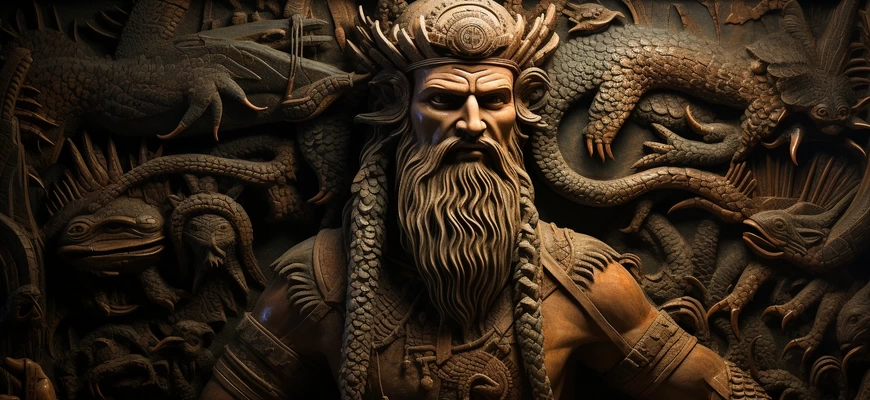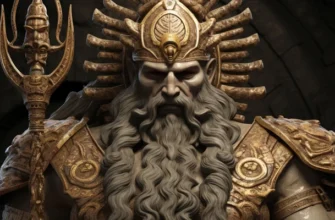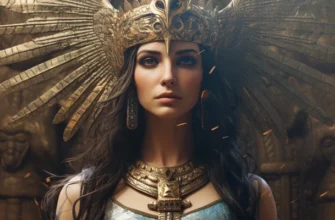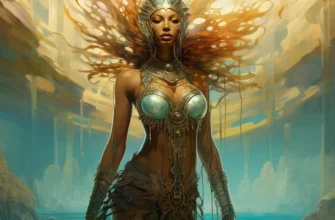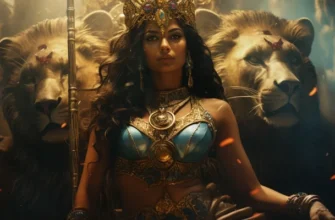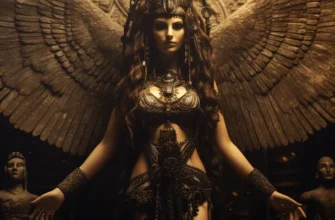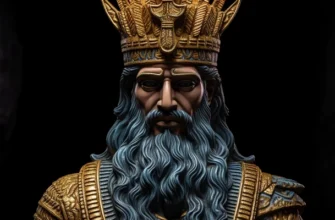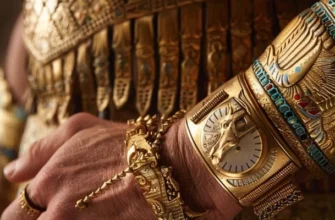The Sumerians, one of the oldest civilizations of mankind, had a magnificent mythology filled with a variety of deities. One of the most important gods in their pantheon was Enki, who was not only the god of water, but also the ruler of the underworld and the patron saint of wisdom.
Enki was often depicted as a man with a fish tail, symbolizing his power over water and fishing. His name translates to “Lord of the Water,” indicating his important role in controlling rivers and various bodies of water.
This god is also known for his wisdom and intelligence. Sumerian texts state that Enki was the one who gave humanity wisdom and knowledge. He often acted as a protector of the city of Eridu, where his shrine is located. According to myths, he also intervened in people’s affairs, for example, helping to save them from the flood. His appearance in the myths is associated with numerous episodes where he performs actions in favor of humanity.
In general, Enki appears to be an important god in Sumerian mythology, combining elements of power over water, wisdom, and a protector of people. He remains a figure of fascination and research, helping to uncover and understand the mysteries of the ancient Sumerian civilization.
- Characteristics of Enki
- Origin and genealogy of Enki
- The main attributes and symbols associated with Enki
- Myths and Legends
- Important episodes of his interaction with other gods
- Role in Sumerian Society
- The economic and cultural role of Enki in Sumerian society
- Influence on the development of science, art, and religion
- Enki in the Modern World
- Enki’s legacy in contemporary culture
- Conclusion
Characteristics of Enki
Enki is one of the key gods in Sumerian mythology, known for his versatility and influence on various aspects of life. His characterization includes the following important aspects:
God of water and fishing:
Enki was associated with water and had power over the water elements. His symbol, a man with a fish tail, indicates his power over rivers, river goddesses, and fishing. He was the patron saint of sailors and those who depended on water for their livelihood.
The patron saint of wisdom:
Enki was the patron saint of wisdom and knowledge. He was considered the source of intelligence and reason, giving humanity wisdom and learned knowledge. His role in teaching and developing the mind made him an important figure in the cultural and religious life of Sumer.
Participation in the creation of mankind:
According to Sumerian myths, Enki participated in the creation of mankind. He used his wisdom and knowledge to form the first couple of humans. His interactions with humans indicate his benevolence and desire to help his creatures.
Intervention in human history:
Enki often intervened in the affairs of humans, performing various actions for their benefit. A well-known episode is Enki’s intervention in saving humanity from the flood, where he warned one of his faithful servants and helped him save his knowledge and life.
Dual character:
There is a dual aspect to Enki – he can display both good and less benevolent traits. This makes him a character with a complex, ambiguous nature, which can be manifested in his actions and relationships with other gods.
All of these aspects combine to create a unique image of Enki, a god who combines power over nature, wisdom, and active participation in the lives of his worshippers.
Origin and genealogy of Enki
Enki is one of the main gods in Sumerian mythology, and his origin and genealogy are reflected in the myths and texts of this ancient civilization. According to the Sumerian legends, Enki was the son of Anu, the highest god of the Sumerians, and Ki, the goddess of the Earth.
His genealogy is connected to the family of Anu, who was the main deity in the Sumerian pantheon. Anu was the ruler of the heavens and the higher gods, and he had other children, such as Inanna, the goddess of love and war, and Enlil, the god of air and war. Enki stood out among his family for his power over water and wisdom.
Legends also tell of how Enki became the ruler of Eridu, one of the great cities of Sumer, where he established his shrine. His role in the creation and nurturing of humanity makes him an important god to the Sumerians.
The genealogical lines and kinship relationships of the gods in Sumerian mythology may vary in different legends and texts, but they always point to Enki’s important role in the hierarchy of Sumerian gods and his influence on various spheres of life.
The main attributes and symbols associated with Enki
Enki, as an important god in Sumerian mythology, is associated with a variety of attributes and symbols that reflect his power and character. The main ones include:
The fish tail:
Enki is often depicted as a man with a fish tail. This attribute symbolizes his power over water and fishing, indicating his patronage of sailors and those who depend on water resources.
Stone tablets:
As the god of wisdom and knowledge, Enki is often depicted with stone tablets or clay tablets. These symbols represent his role in passing on wisdom and teachings to humanity.
Water:
Enki’s power over water is reflected in many ways, including the symbolism of water as a source of life, purification, and regeneration. He appears as a deity who controls rivers and bodies of water.
Hunting net:
Sometimes Enki is depicted with a hunting net or other hunting tools. This may indicate his role in fishing and hunting, as well as his ability to capture and hold various aspects of life.
Snakes and dragons:
Sometimes Anki is associated with snakes or dragons. These creatures can symbolize his power over water, as well as his great wisdom and inner strength.
Chains and keys:
In a number of myths, Enki is represented with chains and keys, indicating his power over the underworld. This emphasizes his role as a god who possesses not only natural elements but also aspects of the mysterious and otherworldly.
These symbols reflect Enki’s versatility as a god with power over water, wisdom, and influence over various aspects of Sumerian life.
Myths and Legends
The Sumerian mythology is full of various myths and legends that reveal the beliefs and ideas of this ancient civilization. Here are some interesting myths and legends:
The myth of the creation of mankind:
According to Sumerian myth, the god Enki and the goddess Ninma created humans from clay. Enki gave them life and intelligence, and Ninma created their various forms. This myth provides an explanation of how humanity came into existence and why different people have different abilities and personalities.
The myth of the flood:
The Sumerian flood myth is similar to the biblical story of Noah. Enki warned one of his faithful servants about the coming flood and advised him to build a big ship to save himself and the representatives of different animal species.
The myth of Inanna and Dumuzi:
This myth tells the story of a love triangle between the goddess Inanna, the god Dumuzi, and the shepherd Hesilbanda. Inanna, enchanted by Dumuzi, is sent to the underworld, but her sister Hershkigal takes over the world. This myth reflects the theme of life and death, as well as the importance of rituals in the Sumerian cultural context.
The myth of Ana and Inanna in the Underworld:
This legend tells how Inanna decided to visit her father Anu’s underworld. She has to go through seven gates and remove her royal attributes at each one. This myth symbolizes the cycles of nature and life.
The myth of Enlil and Dingirsul:
This myth tells of a competition between Enlil, the god of air and war, and Dingirsul, the god of growth and harvest. Their conflict expresses the contradictory aspects of nature and society, as well as the struggle for power in the pantheon of gods.
These myths and legends help modern researchers and readers understand the worldview and values of Sumerian civilization, and make an important contribution to understanding the religious and cultural aspects of the time.
Important episodes of his interaction with other gods
Enki, as a key god in the Sumerian pantheon, participated in numerous episodes of interaction with other gods that determined the course of events in mythology. Here are some important episodes of his interaction:
The creation of mankind:
Enki took part in the creation of humanity together with his sister Ninma (sometimes called Ninma). This episode shows his role as creator and giver of life.
The flood and the rescue of Ziusudra (the Sumerian Noah):
Enki acts as the savior of Ziusudra (analogous to the biblical Noah) in the flood myth. He confidentially reveals to Ziusudra the plans of the other gods regarding the flood, and instructs him to build a ship that will save him and various animal species from the flood.
Combining different aspects:
Enki symbolizes the combination of different aspects of power. In the myth of Dingirsul and Enlil, his actions indicate the unfolding conflict between the deities of growth and war, and Enki acts as a mediator between these conflicting forces.
A trip to the underworld:
Enki interacts with other gods on his journey to the underworld. He passes through seven gates, giving away a part of his royal garment at each of them, in order to save his sister Inanna, who has fallen under the power of her sister Hershkigal.
Interaction with Enlil:
Enki interacts with Enlil, another important god in the Sumerian pantheon. Their relationship can be complicated, sometimes they conflict with each other, competing for power and influence.
These episodes of interaction allow for a better understanding of Enki’s importance in Sumerian mythology and his role in events that shaped the life and cultural beliefs of this ancient civilization.
Role in Sumerian Society
Enki played an important role in Sumerian society, influencing various aspects of life and culture. His role can be seen in several key ways:
Creator and giver of life:
Enki was recognized as the creator of humanity, giving life to the first humans. This belief gave him enormous authority among the Sumerians and made him an object of gratitude and veneration.
The patron saint of wisdom and knowledge:
As the god of wisdom, Enki was an important source of knowledge and intelligence. He was considered a teacher and guide for people, giving them not only life but also wisdom.
He is the patron saint of fisheries and water bodies:
His power over water and fisheries made him the patron saint of sailors and those who depended on water for their livelihood. Enki took on the role of protector and supplier of fish, which was important to the economy and survival of the Sumerian population.
Role in history and events:
Enki often intervened in the affairs of humans and other gods, making important decisions that determined the course of history. For example, his participation in the rescue of Ziusudra demonstrates his important role in preserving life and knowledge.
Connection with the underworld:
Enki also had power over the underworld, making him a key figure in rituals related to death and the afterlife. He often interacted with his sister Erskigal in the underworld.
Influence on cultural practices:
Beliefs in Enki influenced cultural practices, including religious rites, ritualism, and the way holidays were celebrated. His cult was an important component of Sumerian religious life.
Enki’s role in Sumerian society was extremely important, as he combined the functions of creator, protector, teacher, and ruler over water, making a significant contribution to the cultural and religious landscape of this ancient civilization.
The economic and cultural role of Enki in Sumerian society
The economic and cultural role of Enki in Sumerian society was extremely important and played a key role in the stability and development of this ancient civilization.
Fishing and water resources:
Enki, as the god of water and fisheries, influenced the economy of Sumerian society through his control over water. Rivers were vital to agriculture, and Enki’s power over water bodies determined the level of access to resources and the ability to expand agricultural land.
Ensuring harvests:
In his role as god of knowledge and wisdom, Enki influenced agriculture and crop yields. Faithful peasants turned to him for advice and blessings to ensure a good harvest.
Trade and urban development:
Enki was also associated with urban development and trade. Cities that were located near water bodies and rivers benefited from fishing and trade with other regions, which contributed to economic development.
Religious rites and cult practices:
The Enki cult defined the religious rites and cult practices of the Sumerian people. Religious rituals associated with Enki included sacrifices and prayers aimed at ensuring prosperity and promoting agriculture.
A symbol of wisdom and knowledge:
Enki, as a symbol of wisdom, influenced education and knowledge in Sumerian society. The culture centered in Sumerian cities developed around the study and transmission of knowledge, which was reflected in the worship of Enki.
Art and literature:
Enki also had an influence on Sumerian art and literature. Many myths and poems are devoted to his actions and interactions with other gods, which created the basis for the Sumerian artistic and literary tradition.
Rituals and celebrations:
The celebrations and rituals associated with the cult of Enki were marked by specific rites, festivals, and ceremonies that deepened religious and cultural ties in Sumerian society.
Enki’s role in the economy and culture of Sumerian society was decisive, and his influence was noted in all spheres of life of this ancient civilization.
Influence on the development of science, art, and religion
Enki influenced the development of science, art, and religion in Sumerian society, making a difference in these areas through his role as god of knowledge, creator, and patron.
Wisdom and rituals:
Enki symbolized wisdom, and the belief in his power over knowledge supported the development of Sumerian science. He was considered the most intelligent among the gods, which influenced the creation of schools and research centers to transfer knowledge.
Mathematics and astronomy:
Mathematics and astronomy developed in Sumerian society, and this can be attributed to the influence of Enki. He was associated with the solar system and the movement of celestial bodies, which could have sparked interest in the study of astronomy.
Poetry and mythology:
Enki was part of numerous myths and legends that acted as inspiration for art and literature. His interactions with other gods and his roles in the myths served as the basis for Sumerian epic poetry and stories.
Sacred architecture:
The cult of Enki determined the construction of sacred structures such as temples and shrines. The architectural creations of Sumerian cities, particularly Eridu, were aimed at expressing worship of Enki and expressing gratitude for his blessings.
Cult practices:
Enki was the object of cult practices that included rites, sacrifices, and religious festivals. These practices strengthened social and religious ties in Sumerian society.
Religious images and idols:
Enki religious images, such as statuettes and idols, were important objects of cult and worship. Their creation contributed to the development of art and religious craft.
A symbol of morality and ethics:
Enki also symbolized moral and ethical values. His actions and decisions in various myths often served as an example for society, contributing to the formation of the Sumerian value system.
Enki’s influence on the development of science, art, and religion in Sumerian society was broad and complex, helping to shape the cultural and spiritual landscape of this ancient civilization.
Enki in the Modern World
In the modern world, Enki remains an important figure in the context of the study of ancient Sumerian mythology and religion, but his influence is also evident in various aspects of culture and learning.
Historical and archaeological research:
Enki and Sumerian mythology in general are objects of study for archaeologists, historians, and scholars of ancient civilizations. Archaeological finds and excavations help to reconstruct the life of the Sumerians and reveal their beliefs.
Literary and artistic use:
The myths associated with Enki have become the object of literary use in modern works. Writers and artists use these legends as a source of inspiration for new works.
Study and research in religious studies:
Sumerian religion, including Enki beliefs, is a subject of study in religious studies and religious history. Academic writings and research help to gain a deeper understanding of the religious and cultural aspects of the ancient Sumerian civilization.
Public consciousness and pop culture:
Elements of Sumerian mythology, such as Enki, can appear in popular culture, including books, movies, games, and other mass-consumption works. They can become a source of interest to the general public and help preserve the legacy of ancient beliefs.
Symbolism and Philosophy:
Enki can be used as a symbol or allegory to express various ideas and philosophical concepts. Elements of his character and history can be used to reveal aspects of human nature, power and wisdom.
Mythological reinterpretations:
Contemporary writers and creative individuals can create new interpretations of Sumerian myths, bringing their own perspective and context to the traditional stories.
In today’s world, Enki and his mythological legacy continue to play a role in the study of cultural heritage, art, religion, and in a deeper understanding of the evolution of human thought and belief.
Enki’s legacy in contemporary culture
Enki’s legacy in contemporary culture manifests itself in a variety of ways, including art, literature, science, and religious studies. Here, we will examine some of the manifestations of this legacy:
Literature and Art:
Careful work with mythology: Contemporary authors and artists are carefully studying Sumerian mythology, particularly the Enki myths, and using these themes to create new works.
Novels and movies: Elements of Sumerian mythology, including Enki, can be found in modern novels and films, where they are used to create unique and engaging plots.
Studies in Religious Studies:
Academic Research: Enki mythology is a subject of academic research in the field of religious studies. The study of the beliefs and rituals associated with the Sumerian religion expands the understanding of ancient beliefs and their impact on the modern world.
Popular Culture:
Use in games: Sumerian mythology, including Enki stories, can appear in computer games, where they are used as an important element of the plot and gameplay.
Music and art: Creators of contemporary music and art can find inspiration in the Enki myths, creating works that reflect his images and stories.
Science and Astronomy:
Names of space objects: Elements of Sumerian mythology, such as the names of the gods, can be used in astronomy to name planets, stars, and other cosmic objects.
Philosophy and Symbolism: Enki can act as a symbol to express various ideas and philosophical concepts in the modern world. His image can serve to reveal aspects of human nature and ethics.
Heritage in Religion:
Neopagan movements: Some neopagan movements may incorporate elements of Sumerian mythology, including the cult of Enki, into their beliefs and rituals.
Enki’s legacy in contemporary culture manifests itself in many forms, sparking interest and inspiration for those who study or create cultural works. The Enki and their stories continue to live on in the modern world as part of the multifaceted heritage of ancient civilizations.
Conclusion
In conclusion, it can be determined that the Sumerian god Enki played an extremely important role in the development and formation of the Sumerian civilization. His various aspects, from the creator and patron of wisdom to the ruler of water and the underworld, made him a central figure in the religious, cultural, and social life of the ancient people.
Enki’s role in Sumerian history and culture was manifested in his influence on agriculture, fishing, art, science, and religious rites. His image and myths became not only the basis for the beliefs of the time, but also a source of inspiration for modern scholars, writers, artists, and cultural creators.
Enki remains a key figure for understanding Sumerian history and culture. Studying his role in ancient beliefs and traditions provides a unique perspective on how a civilization developed and interacted with its own deities. Enki remains an important subject for research, revealing the depths of history and the influence of ancient gods on the formation of cultural values and traditions.
